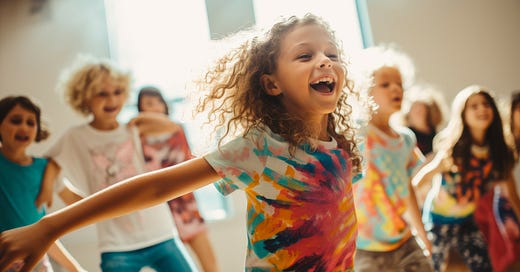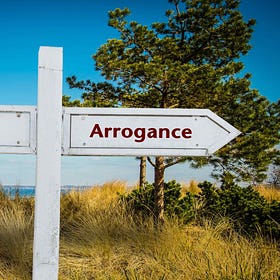One of my biggest goals as a parent is to raise kids who will grow up to be good human beings — who are compassionate, generous, yet also willing to fight for what they believe in. In my first book, I talked a lot about the roots of compassion, including a foundational skill known as “theory of mind.” Theory of mind is the ability to take other people’s perspectives — to recognize that other people can have different thoughts, experiences and feelings than we do. Theory of mind gives kids (and adults!) the capacity to consider how their choices affect others, and it also helps them recognize that, even when they are feeling great, other people could be having a hard time. (And vice versa.)
In my book, I shared a bunch of key strategies for building theory of mind skills. And then, just a few days ago, I stumbled across of series of studies suggesting another surprising and heartwarming route to compassion: music and dance.
The research on this topic is still in its infancy — at this stage I’d categorize this as a compelling idea more than a proven method — but it’s fascinating. Studies suggest that acting in synchrony with others, as often happens when making music or dancing, builds theory of mind skills and makes people more compassionate and helpful.
In a landmark study that helped to spark interest in this phenomenon, USC organizational psychologists Scott S. Wiltermuth and Chip Heath conducted a series of experiments in which adult participants were assigned in groups to different conditions. Some groups listened to the song “O Canada” together, but didn’t dance or sing; some listened and sang along to the song with the rest of their group (some even moved plastic cups in tandem with the music and each other); and some listened to the song with their group but sang at different rates and moved plastic cups at different times.
Then, the groups played a cooperation game together in which they were each asked to contribute money to a pot from which everyone would take an equal share. The more cooperative the participants felt, and the more they trusted the others to act cooperatively, the more money they would donate and ultimately receive. If they didn’t feel they could trust the others, or didn’t feel like cooperating, they would give and receive less.
The researchers found that the participants who had initially sung synchronously with the others in their group out-cooperated those in groups who did not sing together or who sang and moved out of sync with each other.
Studies involving kids have gotten similar results. In one, researchers paired 4-year-olds together. Some danced around a pond while singing a song together and playing percussion instruments in time with each other, while other pairs moved around the pond without singing and playing instruments together. Each of the kids was then given a task to complete before playing a fun game: To carry marbles in a tube to a new location. The tube of one child in each pair was prepared so the marbles would “accidentally” fall out en route, and the researchers watched to see whether the other child in the pair would stop to help their partner, which came at a cost because it delayed their chance to play the fun game.
The kids who’d made music together, the researchers found, were more likely to stop and help their partner than were the kids who moved around the pond without making music together — which suggests that moving and singing in time with a partner made kids more willing to help.
Another study found evidence of this effect among mere 14-month-old babies. The babies were either held and gently bounced to music in synchrony with a person they faced, or they were held and gently bounced to music out of synchrony with a person they faced. The babies were then put in a situation in which they had the opportunity to help the person they’d been facing by handing her an object she’d “accidentally” dropped. The babies who’d been bounced in synchrony with her were more likely to help than those who’d been bounced out of synchrony with her.
Why does moving or singing in time with others make people more generous and helpful? There could be a number of reasons. For one thing, research suggests that people feel more aligned with, and have more rapport for, others they have moved in sync with. Moving with others may direct people’s attention to those they’ve been moving with, helping them recognize that those people have experiences and wants that are worth considering. One study found that synchrony made people less able to distinguish their faces from those they had synched up with, essentially blurring the boundaries between self and other.
Synching up with others also helps people infer and predict people’s future behaviors. One study found that people who’d moved in sync with a partner were then better able to work together with that partner when navigating a steel ball through a wooden labyrinth, a task that required them to predict their partners’ subtle movements while dynamically adjusting their own. Scientists speculate that the predictive powers we gain from being in sync with people may also extend to mental and emotional states — that moving in time with others may help us tune into how those people feel and what they might need. Some researchers have even designed and tested music- and dance-based interventions based on this notion, reporting that these approaches can, in fact, boost empathy in kids.
“When we move together in time with others, understanding their behavior becomes a much simpler task as the behavior of others is matched in our own, making it cognitively less demanding and less difficult to reason about their mental states,” researchers explained in a 2015 paper. “In doing so, individuals become better able to learn from, coordinate, cooperate, and empathize with others — shaping human sociality.”
There’s a lot left to learn about this phenomenon and the situations in which it could be helpful. But perhaps this is one reason why music and dance can be healing on both an individual and collective level — and it’s a potential tool we can use as parents to help our kids connect with and respond to those around them. Singing and dancing with our kids, and encouraging them to do the same with others, could be a powerful way to foster social cohesion within our families and communities — and, perhaps, throughout the world.
What are your thoughts on this idea? Share in the comments!
The Reassuring Truth About Lies
I’m giving a handful of talks this summer (if you want to hire me, please contact me!), and one issue I’m frequently asked to cover is children’s lying. I can’t say I’m surprised; I imagine every parent has had the experience of their kid lying to them and then has wondered what the hell it means and how to respond.
When Kids Refuse to Share
What should you do when your kids don’t share — and what’s the best way to encourage them to? Here are some science-backed strategies.
How To Raise Humble Kids
A few months ago, I wrote about the fascinating reasons why kids are annoyingly overconfident. Today, I'll unpack some of the recent science on fostering humility in children.










I love this so much!! I play music in my house a LOT and sing and dance with my kids (though it’s a bit complicated with my daughter- she has Misophonia and also high functioning autism- theory of mind is so much harder for her, so this makes me interested to learn more!)
So, I have this friend group - we’ve been friends and known each other since 85-86 when we met at a teenage dance club! Many of us reconnected a couple of years ago when another friend moved back to the area to care for her dying parents. We have weekly meetups at a local brewery (some of us also go to a weekly vinyl night at the brewery) and we routinely meet up to go out to local music events and concerts. Music and dancing at the teenage club brought us together. All of this jives - it’s a group of some of the best people! Kind, compassionate, helpful… we all got each other’s backs. We also have made friends with the younger groups of kids and adults (obviously 21+) that come out to shows and the breweries. Music absolutely connects us.
This feels intuitively very true- I'm glad some folks are researching it! I think that playing music with other people is one of the very best human experiences. My son is currently in a suzuki music program, which has a heavy emphasis on ensemble playing, even with the very youngest students. They learn to watch and listen to each other, read each others' cues, and practice both leading and following. So many good skills.